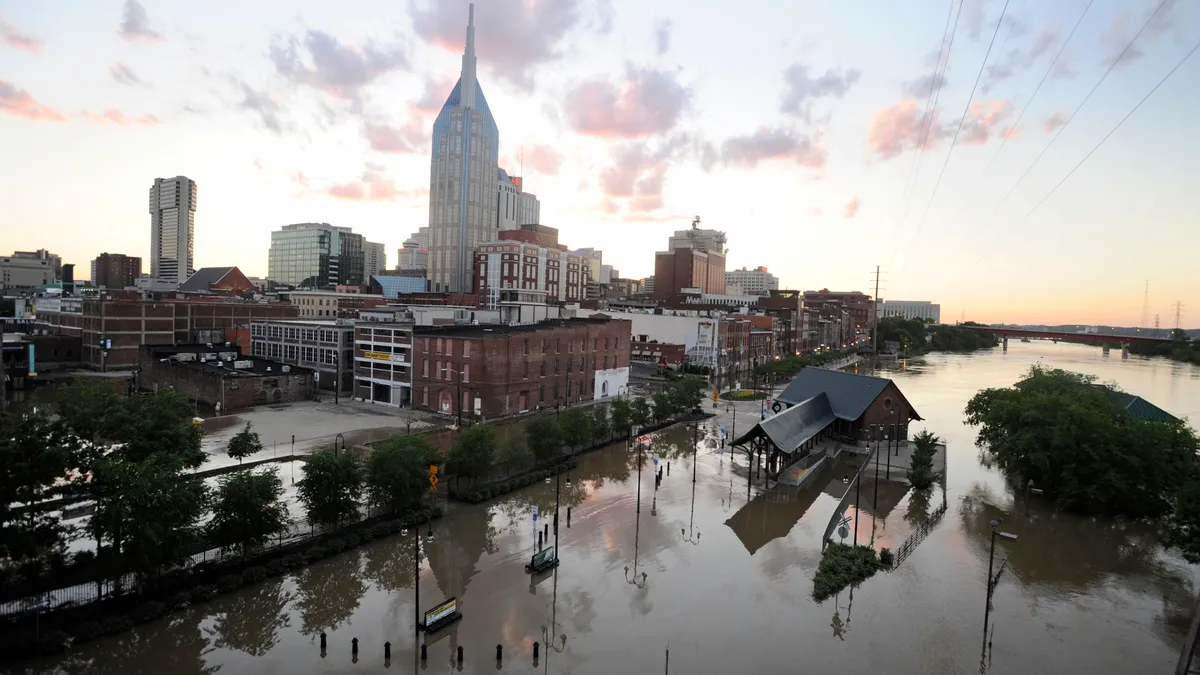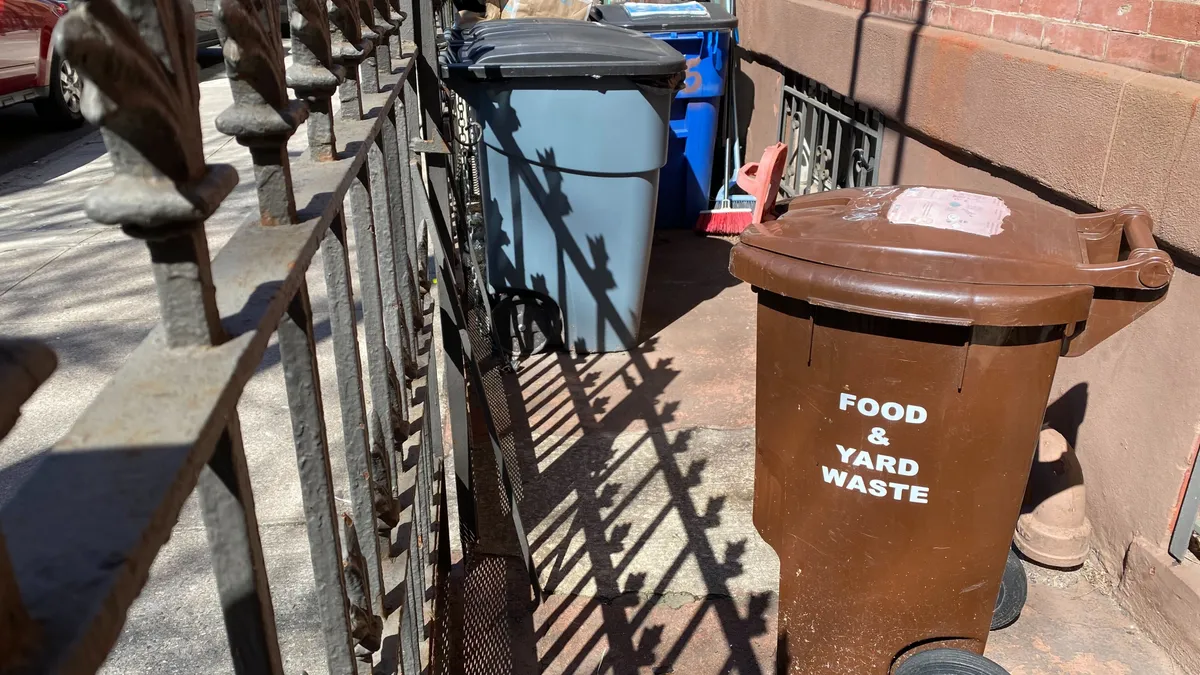Ann Arbor has been busy since adopting its climate action plan just over a year ago.
The Michigan city has installed solar panels on roofs, landfills and public buildings; planted thousands of trees on private land in underserved areas; purchased electric city vehicles and improved efficiency at affordable housing units, said Missy Stults, Ann Arbor’s sustainability and innovations manager. Existing funds and grants are paying for these efforts to reach its goal of net zero carbon emissions by 2030, she said.
Ann Arbor is one of the many U.S. cities with ambitious climate action plans. Over 1,800 cities have declared climate emergencies, and many have accelerated targets for carbon neutrality, according to a new report by the city consulting firm Bloomberg Associates. However, cities have struggled to move from planning to execution.
A 2020 report by the Brookings Institution found that two-thirds of the 100 largest U.S. cities with greenhouse gas reduction goals are lagging in meeting their emissions targets. On average, cities still need to reduce their annual emissions 64% by 2050 to reach their greenhouse gas targets, the report states.
And it's not just a U.S. problem. Cities worldwide are behind on their carbon emission targets, according to the report by Bloomberg Associates, which, in partnership with the Global Covenant of Mayors for Climate and Energy and the World Resources Institute, interviewed over 50 city officials and surveyed officials in an additional 300 cities. The slow rollout of these initiatives has been caused by a lack of financing, a lack of buy-in across city departments, and not having the staffing or tools needed to push climate projects forward, the report states.
"There is a lot of focus on creating plans, creating carbon inventories, creating climate action plans," said Adam Freed, a principal at Bloomberg Associates and an author of the report. "The same skill set that helped me create a plan is not the same one that helps project-manage the solutions."
Reaching emission targets sometimes requires savvy public messaging about the multiple benefits of carbon reduction measures beyond going green and action outside city boundaries through partnerships from the broader region, the report’s authors said.
'We have got to do something'
Ann Arbor needs more money to pay for some of its other important climate initiatives, such as expanding its composting and recycling program, making its buildings more resilient to flooding and launching energy efficiency programs targeting low-income residents, said Stults.
This month, Ann Arbor’s mayor introduced a 20-year local property tax increase to pay for the climate plan, an action that would need approval through a citywide vote. So far, several city council members have been skeptical about the financial burden it would place on taxpayers, according to MLive.
Financing climate plans is a major challenge for cities, according to the Bloomberg Associates report: 47% of cities reported financing and investments from national and regional governments as a top challenge; 40% cited securing funding within the city operating budget and 31% cited securing funding within capital plans. In the U.S., a new report by the nonprofit CDP identified over 300 sustainable infrastructure projects in nearly 100 cities that have a collective funding and financing gap tallying at least $10.6 billion.
Stults said the Biden administration’s $1.2 trillion infrastructure plan currently under debate in Congress could help Ann Arbor implement some of its larger transportation initiatives. The Biden administration is separately pursuing a $3.5 trillion bill that would provide funding for climate initiatives among a host of other priorities. The infrastructure plan has gained some bipartisan support in the Senate, but the administration is advancing the $3.5 trillion bill without Republican support through a procedure that only requires a simple majority vote in the Senate.
In Ann Arbor, Stults said she understands the affordability concerns surrounding a new tax to finance the city’s climate plan, but due to the state’s laws, Michigan cities have limited ways to generate new revenue. Such an initiative would help Ann Arbor’s local economy, businesses and residents, she says, noting that climate change has caused record rainfalls that have overwhelmed the city’s infrastructure.
"We have to do everything we can to reduce climate pollution so that we are avoiding the most catastrophic impacts of climate change," said Stults. "Climate change is already here. We have got to do something."
Staffing and buy-in challenges
Financing is not the only issue cities face in trying to get their climate initiatives off the ground. Cities often have access to technical expertise to develop a climate program, according to the report, but they lack sufficient staff who can actually execute those projects, causing recurring delays.
Despite making progress in building centralized sustainability teams, cities also have struggled to galvanize buy-in from their key administrative agencies, such as finance and transportation departments. And, a lot of the tools or data technologies that city leaders use to help plan their climate work, manage projects, or identify risks do not support key activities that enable implementation, the report said. For instance, tools tend to be too technical or engineer-focused or they don't help city leaders explain the equity and outcome benefits of certain policies or projects.
To help speed up the pace and deepen the scale of their climate action, cities need to build a culture of sustainability throughout their leadership, according to the report. That means engaging the rest of the city government — including department heads, finance, and city managers — and integrating climate into citywide plans.
Many cities are also still in the early stages of climate action and spending their time building greenhouse gas inventories or developing a plan. But, according to the report, cities and their partners should put more time and attention into individual projects or policies to get started on execution.
To drive down emissions, cities need to think regionally as well, and collaborate on projects through partnerships with neighboring cities within their metropolitan region, the report said.
"Cities don’t always control all the levers that they need to effect the change," said Freed.
Sometimes political barriers can bring unique challenges for even the most climate-supportive mayors, requiring them to be strategic in their messaging. The vast majority of the cities that responded to the survey said climate was a top priority or an important issue for their mayor. But city employees are often unable to articulate a compelling case for individual projects or policies beyond emission reductions, making it difficult to get climate projects prioritized, the report said.
Nashville hasn’t yet formally adopted a climate action plan but is tackling initiatives its mayor’s sustainability advisory committee recommended to reduce greenhouse gas emissions by 80% from 2014 levels by 2050 for both the city’s government operations and the wider Davidson County. These efforts have include a home efficiency program, a 500,000 trees campaign, a food-saver challenge for restaurants and hotels to cut down on waste, updated building codes to include higher efficiency standards and more solar energy
Successive mayors over the past decade have supported the goal of making Nashville "the greenest city in the Southeast"— a region of the U.S. where climate action is often considered less of a a priority, and conservative tax policies can make financing initiatives difficult, said Mary Beth Ikard, Nashville’s director of sustainability and resilience. Yet, some climate-impactful policies have been popular among the city’s constituents, she said.
That’s because many of the initiatives the city has pursued have benefits beyond lowering the city’s carbon footprint, which the city stresses, said Ikard. For example, retrofitting large commercial buildings or aging single-family housing to be more energy efficient has a significant workforce development and jobs component and has public health benefits.
"We, as a broader community practice, haven't done a good job in telling the story of why climate action does things like improve air quality, deliver on equity goals, improve public health, prevent flooding [or] reduce congestion," said Jake Elder, a Bloomberg Associates adviser and co-author of the report. "We get sucked sometimes in this battle between good climate policy and just good transportation policy, or good urban planning. But in reality they are one and the same."




















